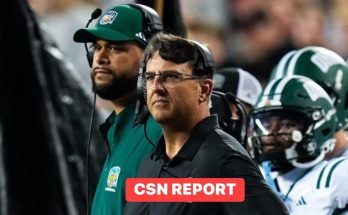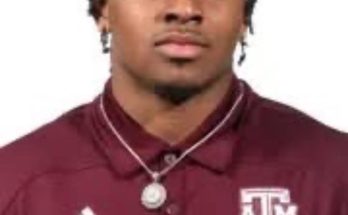Florida Gators quarterback DJ Lagway’s offseason took an unfortunate turn when he was recently seen wearing a walking boot due to a reported leg injury. For fans who were excited about the 5-star freshman’s arrival and the buzz he brought to Gainesville, this latest setback is a jarring reminder of how fragile the transition from high school stardom to college football dominance can be. It’s also an early test for both the player and the program. Lagway’s injury, reportedly a lingering or re-aggravated issue from earlier this year, casts a bit of uncertainty over what was shaping up to be one of the most highly anticipated quarterback competitions in the SEC heading into the 2025 season. For Florida, a team desperately trying to rebound from another disappointing season and restore the glory days under Billy Napier, this development complicates an already high-pressure scenario.
DJ Lagway came into the Gators’ program with one of the most decorated high school resumes in recent memory. A consensus 5-star prospect and the No. 2 quarterback in the 2024 class, Lagway brought with him not only elite physical tools but a leadership aura and work ethic that instantly resonated with teammates and coaches. In spring practice and early summer workouts, insiders raved about his arm talent, his ability to throw off-platform, and how quickly he was grasping the Gators’ offensive playbook. Although he was still in a battle with incumbent starter Graham Mertz, many around the program viewed it as only a matter of time before Lagway would be named the starter. His upside, raw as it may be in some areas, was simply too tantalizing to ignore for a Florida team needing a spark.
The news of Lagway being in a walking boot, then, feels like an unfortunate disruption to that momentum. While neither Lagway nor the team has gone into detail about the exact nature of the injury, early reports suggest that it’s related to a lower-leg strain or sprain—something that flared up during drills and has since required him to be sidelined temporarily. A walking boot is often a precautionary measure in these situations, but that doesn’t lessen the concern for Gator fans who were hoping to see Lagway build consistency through fall camp and potentially seize the starting role before the season opener. Any disruption at this stage is critical, not just from a physical standpoint, but because every rep matters for a young quarterback trying to learn the speed and complexity of the college game.
This is not the first time Lagway has dealt with leg issues. In his senior year of high school, he missed a few games with a minor lower-body injury that initially didn’t seem serious but lingered longer than expected. That context adds another layer to the current situation. While Florida’s medical staff is undoubtedly monitoring things closely and taking every precaution to prevent long-term damage, recurring leg injuries—especially early in a quarterback’s career—are something to be taken seriously. Lagway’s game is built in part on mobility. He’s not a run-first quarterback, but he’s an instinctive scrambler and excels when the play breaks down. If his lower body isn’t 100 percent, it not only affects his ability to evade pressure but could also impact his throwing mechanics and confidence in the pocket.
From a programmatic standpoint, this injury could have ripple effects on Florida’s quarterback depth chart and overall offensive strategy. Graham Mertz, the former Wisconsin transfer who started for Florida last year, was presumed to be Lagway’s biggest competition this fall. Mertz is a known commodity—solid but unspectacular. He offers stability, experience, and a decent grasp of the offense but lacks the upside that Lagway possesses. With DJ potentially sidelined for a chunk of fall camp or being limited in practice, it tilts the scales back toward Mertz, at least in the short term. That’s a strategic consideration for Napier and his staff. Do they rush Lagway back to try and salvage the competition? Or do they play it cautious, preserving his long-term health even if it means limiting his chances to start early in the season?
This injury also impacts the locker room dynamic. Lagway had been emerging as a vocal leader, particularly among the younger players. His presence at quarterback symbolized a new chapter for the program—a break from the inconsistencies of past signal-callers. A temporary absence creates a leadership vacuum, even if only subtly, and forces other players to step up. For the offensive line, receivers, and running backs, adjusting to a quarterback rotation or an uncertain starter can slow down chemistry-building and execution in practice. That, in turn, could delay the offense’s readiness by the time Florida’s brutal early-season schedule kicks in, including games against Miami, Texas A\&M, and Tennessee within the first month.
There’s also a recruiting lens through which this situation is viewed. Lagway’s presence in Gainesville was already having a ripple effect on recruiting. He had been instrumental in helping recruit skill-position players, particularly wideouts and running backs, who were drawn to the idea of catching passes from a future NFL talent. His injury—even if not severe—could raise some questions among potential commits about how soon the DJ Lagway era will truly begin and whether he’ll be the face of the offense right away. It also reinforces the importance of roster depth. If Lagway isn’t ready to go full speed by the opener or needs to sit out early games, Florida will need to lean more heavily on other scholarship quarterbacks, who may not have the same star potential.
At the same time, this could become an early proving ground for Lagway’s mental toughness and maturity. Every elite quarterback faces adversity. For some, it’s not getting playing time right away. For others, it’s adjusting to the complexity of college schemes. And for many, it’s injuries. How Lagway responds to this challenge—whether by staying engaged in meetings, supporting teammates from the sideline, or attacking his rehab—will say a lot about his leadership and commitment. It’s also a chance for him to show that he can be patient, something not always easy for five-star recruits who’ve been dominant their entire athletic lives.
In a best-case scenario, Lagway returns to full health before the start of the season, regains his momentum, and picks up where he left off. Even then, the time lost could be significant. Fall camp isn’t just about running plays; it’s about building timing with receivers, understanding blitz pickups, mastering situational football, and developing chemistry with the coaching staff. For a freshman, those reps are irreplaceable. If he misses them, it likely pushes back his timeline for starting or making a major impact. It could even shift the developmental arc of his freshman year from “potential starter” to “high-impact backup who gets meaningful snaps late in the year.”
For Billy Napier and his staff, Lagway’s injury is another variable in what is already shaping up to be a make-or-break season. After two underwhelming campaigns, Napier is under pressure to produce results—not just flashes of potential, but wins. Having a healthy, dynamic quarterback is a major part of that equation. The coaching staff has been under scrutiny for player development and game management. If Lagway isn’t healthy and the offense sputters with Mertz or another quarterback at the helm, it won’t take long for critics to circle back to questions about Florida’s preparation, strength and conditioning protocols, and overall player management.
Florida’s fans, of course, are used to turbulence at the quarterback position. Since the days of Tim Tebow, it has felt like a revolving door of inconsistency, untapped potential, and missed opportunities. Lagway was supposed to be the long-awaited savior—the guy who could bring stability, explosiveness, and star power back to the Swamp. The walking boot, though temporary, is a harsh reminder that the road back to relevance won’t be smooth, and that even the brightest prospects are vulnerable to the physical grind of the sport.
Still, it’s far too early to panic. Lagway has youth on his side, elite training resources, and a program that has made clear he’s their quarterback of the future. The key now is ensuring that the “future” doesn’t get delayed too long or derailed altogether by trying to rush him back too soon. Florida has to weigh short-term needs against long-term gains. Pushing Lagway into action before he’s fully healed could have lasting consequences, not just for his freshman year, but for his entire college career. On the other hand, easing him back, even if it means sacrificing early games, could allow him to return stronger, more confident, and more capable of leading the team when it matters most—in the thick of SEC play and beyond.
Ultimately, DJ Lagway’s injury is a pivotal moment—not a catastrophe, but a crossroads. How he recovers, how the coaching staff navigates the quarterback room, and how the team rallies in his absence will define not just the 2025 season, but potentially the trajectory of the Napier era at Florida. For now, all eyes will remain on that walking boot, the timeline of his return, and the hope that this temporary pause is just that—a pause, not a setback.



